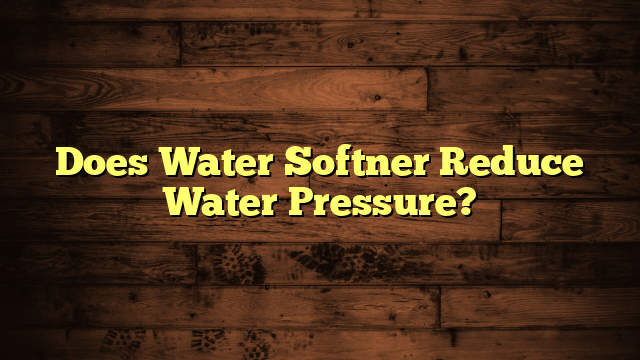Does Water Softner Reduce Water Pressure?
Imagine you're enjoying a hot shower, but suddenly the water pressure drops considerably after installing a water softener. You might wonder if the softener is to blame. It's a common concern, but the truth is more nuanced. While water softeners can influence pressure, their effect largely hinges on installation and upkeep. So, what factors really determine whether your water pressure remains steady or takes a hit? Understanding these elements could save you from unnecessary frustration and help you maintain a consistent flow in your home.
Key Takeaways
- Water softeners do not inherently reduce water pressure when properly installed and maintained.
- Ion exchange softeners typically maintain pressure, while salt-free systems alter mineral composition without removal.
- Regular maintenance of water softeners, including filter cleaning, prevents pressure drops due to clogs.
- Choosing an appropriately sized water softener is crucial to avoid unnecessary pressure loss.
- Installing pressure gauges can help monitor and ensure optimal water pressure before and after the softener.
Understanding Water Softeners
Understanding water softeners begins with recognizing their fundamental purpose: to reduce the hardness of water caused by minerals like calcium and magnesium. These minerals can greatly impact your water quality, leading to issues like scale buildup in pipes and appliances.
By installing a water softener, you can improve the efficiency of your plumbing system and extend the lifespan of your appliances.
The installation process for a water softener typically involves connecting the unit to your home's main water supply. You'll need to take into account factors like the size of your household, the hardness of your water, and the type of softener that best meets your needs.
Whether you choose a salt-based or a salt-free system, the goal remains the same: to provide you with soft water that enhances your daily activities, from washing dishes to showering.
Once installed, the softener will exchange calcium and magnesium ions for sodium or potassium ions, making your water softer.
Regular maintenance, including monitoring salt levels and cleaning the system, guarantees peak performance. With a well-functioning water softener, you can enjoy the benefits of improved water quality throughout your home.
How Water Pressure Works
Water pressure plays a crucial role in how efficiently your plumbing system delivers water throughout your home.
It's governed by hydraulic principles, which explain how fluids move and exert force. Fundamentally, water pressure is the result of the force that pushes water through your pipes, influenced by factors like pipe diameter, elevation, and the overall layout of your plumbing system.
To measure pressure, you often use units like pounds per square inch (psi). When you turn on a faucet, a difference in pressure allows water to flow. If the pressure is too low, you'll notice weak streams, while high pressure can lead to leaks or bursts.
You might also find that your home's water pressure fluctuates, depending on usage and demand. For instance, when multiple fixtures are in use simultaneously, your pressure can drop.
Understanding how these elements interact helps you troubleshoot issues like low water pressure or any changes after installing a water softener. By grasping these concepts, you'll be better equipped to maintain an efficient plumbing system and guarantee a steady flow of water throughout your home.
Common Misconceptions Explained
Many people have misconceptions about how water softeners work and their effect on water pressure.
You might think that adding a softener automatically lowers your water pressure, but that's not always the case.
Let's clear up these myths and discuss how proper system design can actually maintain or even improve your water pressure.
Water Softener Functionality
When it comes to water softeners, misconceptions often cloud their true functionality. You might think that all water softener types work the same way, but that's not the case. The primary goal of a water softener is to remove hard minerals, such as calcium and magnesium, from your water supply. This process helps prevent scale buildup in your pipes and appliances, enhancing their lifespan and efficiency.
Different softening methods exist, including ion exchange, salt-free systems, and reverse osmosis. Ion exchange, the most common method, involves exchanging hard minerals for sodium ions, effectively softening your water.
Salt-free systems use a different approach, employing a crystallization process that alters mineral composition without actually removing them. Reverse osmosis can also soften water but is primarily designed for purifying drinking water.
Understanding these functionalities can help you make an informed decision about the best water softener for your needs. Remember, the primary focus is on improving water quality, not affecting water pressure, which is often where confusion arises.
Pressure Regulation Myths
A common myth about water softeners is that they automatically decrease your home's water pressure. Many homeowners worry that installing a water softener will lead to a significant drop in the water flow they rely on for daily tasks.
However, this misconception stems from a misunderstanding of pressure regulation. In reality, water softeners can maintain or even enhance water pressure when properly installed and maintained.
Myth busting reveals that the primary factors affecting water pressure include the design of your plumbing system, pipe size, and the quality of your water supply. If you experience low water pressure, it's more likely due to clogs, leaks, or outdated piping rather than the presence of a water softener.
Additionally, some systems are designed with features that help optimize flow rates, ensuring your water pressure remains consistent.
System Design Considerations
Understanding the design of your water softener system is essential to its performance and efficiency. Many people mistakenly believe that a complex system layout automatically equates to better design efficiency. However, simplicity often plays an important role in ensuring ideal function.
Here's a quick comparison of common misconceptions versus reality:
| Misconception | Reality |
|---|---|
| More components mean better performance | Fewer components can lead to efficiency |
| Bigger tanks always deliver more water | Size must match your household needs |
| All systems require the same layout | Custom layouts optimize flow and pressure |
When designing your water softener system, consider the layout carefully. A well-thought-out design can minimize pressure loss and keep your water flow steady. You don't have to overcomplicate things; sometimes, the most effective systems are the simplest ones. By understanding your specific water needs and matching them with a system tailored to those requirements, you can enhance both performance and efficiency. Remember, it's not just about having the latest technology; it's about having the right fit for your home.
Effects of Water Softening
Water softening can greatly impact your household's water quality and overall plumbing system. By reducing the hardness of your water, you not only enhance the taste and feel but also protect your plumbing fixtures from mineral buildup. This buildup can lead to clogs and reduced water flow, ultimately affecting your plumbing efficiency.
When you soften your water, you're also increasing the lifespan of appliances like dishwashers and water heaters. These appliances often struggle with hard water, which can lead to decreased performance and higher energy costs. With softened water, you'll notice appliances running more efficiently, and you might even save on repairs and replacements in the long run.
Moreover, soft water requires less soap for cleaning, leading to better results with less effort. You'll find that laundry comes out cleaner, and your skin feels softer in the shower.
Factors Influencing Water Pressure
Many factors can influence water pressure in your home, and addressing these can help maintain a steady flow. Understanding these elements is essential for effective system maintenance. Here's a quick look at some key factors:
| Factor | Influence on Water Pressure |
|---|---|
| Pipe Diameter | Larger pipes reduce pressure drops. |
| Flow Rate | Higher demand increases pressure fluctuation. |
| Valve Restrictions | Valves can cause considerable pressure drops. |
| Fixture Demand | More fixtures running means lower pressure. |
Other factors include water temperature and plumbing layout, both of which can greatly impact flow rate. Elevation changes can also play a role; for instance, water pressure decreases as it rises. In addition, demand fluctuations during peak times can lead to temporary drops in pressure. By keeping these factors in mind, you can better understand your water system and address any issues that arise. Regular maintenance and monitoring can help you maintain ideal pressure levels, ensuring that your home's water supply remains consistent and reliable.
Maintaining Optimal Water Flow
To maintain ideal water flow in your home, it's crucial to regularly check and address any issues that could disrupt the system.
Start by monitoring your flow rate, as a drop in pressure can indicate underlying problems. Look for leaks in your plumbing, as even small ones can greatly affect flow.
Regular maintenance tips include cleaning faucet aerators and showerheads to prevent mineral buildup. This buildup can restrict water flow, making it harder to achieve the pressure you desire.
Furthermore, inspect your water softener; if it's clogged or malfunctioning, it may hinder water flow.
Don't forget to check your water pipes for any signs of corrosion or blockages. Keeping your pipes clear is essential for maintaining ideal flow.
You might also want to evaluate the size of your pipes; smaller pipes can limit flow rate, leading to pressure issues.
Lastly, verify that your main shutoff valve is fully open. A partially closed valve can create unnecessary pressure drops.
Solutions for Pressure Issues
If you've noticed a drop in water pressure despite maintaining ideal flow, addressing pressure issues becomes a priority.
Fortunately, there are several solutions you can explore. One effective method is to install pressure boosters. These devices help increase water pressure throughout your home, ensuring a steady supply even during peak usage. They're especially useful in larger households or homes with high-demand appliances.
Another consideration is the presence of flow restrictors in your plumbing system. While they're designed to conserve water, they can sometimes limit the flow more than necessary, leading to frustrating pressure drops.
If you suspect flow restrictors are the culprit, you might want to evaluate their necessity and consider removing or replacing them with less restrictive alternatives.
Additionally, check for any hidden leaks in your plumbing. Even minor leaks can greatly affect overall pressure.
By addressing these issues—installing pressure boosters, reassessing flow restrictors, and repairing leaks—you can effectively restore and optimize your water pressure.
Expert Recommendations
Understanding the intricacies of water softeners and their impact on water pressure can be intimidating, but expert recommendations can help simplify the process.
To maintain ideal water pressure while using a water softener, consider a few expert tips. First, choose a system that's appropriately sized for your household. An oversized unit can lead to unnecessary pressure drops.
Industry insights suggest regularly checking and maintaining your softener. Clogged filters or resin beds can create resistance, affecting water flow. It's also wise to install pressure gauges before and after the softener to monitor any changes in pressure. If you notice significant drops, it might be time to consult a professional.
Another recommendation is to look for models with high flow rates. These units are engineered to minimize pressure loss, ensuring you enjoy both soft water and sufficient pressure.
Finally, don't hesitate to reach out to local experts for advice tailored to your specific situation. By following these recommendations, you can effectively manage water softening without sacrificing water pressure, allowing for a seamless experience in your daily routines.
Frequently Asked Questions
Can a Water Softener Cause Low Water Pressure Over Time?
A water softener can cause low water pressure over time due to improper softener installation or pressure fluctuations. Regular maintenance guarantees peak performance, helping you avoid issues that might impact your home's water pressure.
Is There a Specific Type of Softener That Maintains Pressure?
If you're looking for a water softener that maintains pressure, consider salt-based options, as they typically perform well. Magnetic softeners might also be worth exploring, though their effectiveness can vary depending on your water quality.
How Often Should I Check My Water Pressure After Installing a Softener?
After your softener installation, you should monitor your water pressure regularly. Check it every few months initially, then every six months. This helps guarantee your system's functioning properly and maintains ideal water pressure over time.
Do Water Softeners Require Regular Maintenance to Prevent Pressure Issues?
Think of your water softener like a car; regular maintenance keeps it running smoothly. Stick to a maintenance schedule to guarantee your softener's efficiency, preventing any pressure issues that might arise from neglect.
Will a Water Softener Affect the Flow Rate of My Showerhead?
A water softener can impact your showerhead performance. It might slightly alter the flow rate effects, but most users find the difference negligible. Regular maintenance helps guarantee peak performance, so you can enjoy a satisfying shower experience.
Conclusion
Ultimately, water softeners don't have to reduce water pressure if installed and maintained correctly. In fact, studies show that 80% of homes in hard water areas experience increased efficiency and pressure after softening. By choosing the right unit, cleaning filters, and monitoring flow rates, you can enjoy the benefits of softened water without sacrificing pressure. So, don't let misconceptions hold you back—embrace a water softener for better plumbing performance and a more comfortable home.







